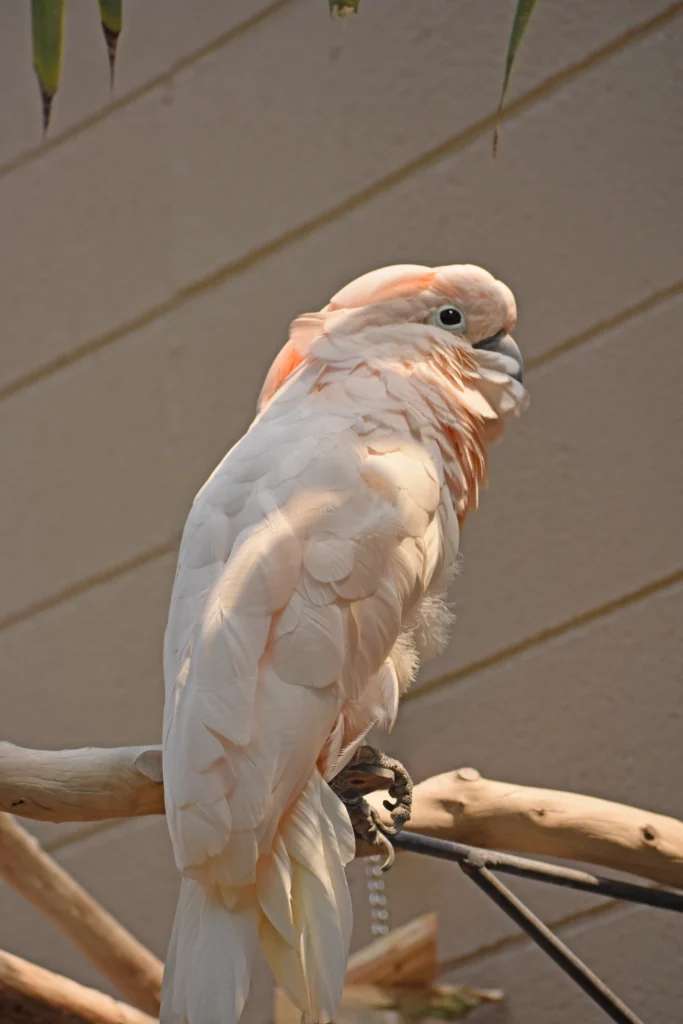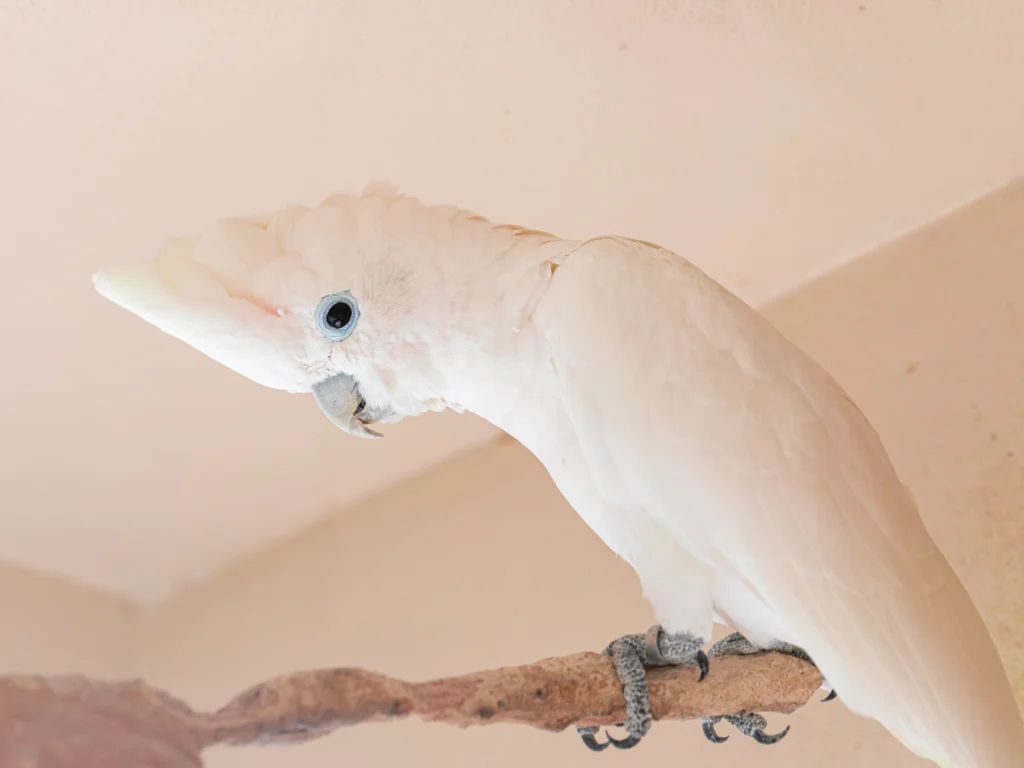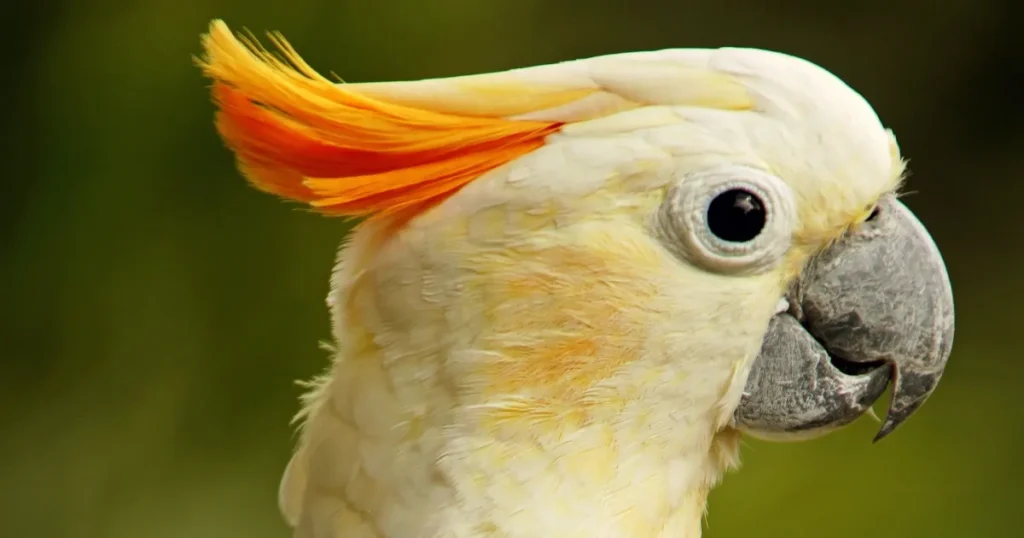Table of Contents
- Understanding the Majestic Moluccan Cockatoo
- Essential Care Requirements for Your Moluccan Companion
- Creating the Perfect Living Space for Your Malakin Cockatoo
- Nutritional Needs and Dietary Guidelines
- Social Behavior and Personality Traits
- Health Monitoring and Common Medical Issues
- Training Techniques and Behavioral Management
- Exercise Requirements and Mental Stimulation
- Legal Considerations and Adoption Guidelines
- FAQ
The Malakin Cockatoo, also known as the Moluccan Cockatoo, is a stunning bird. They come from the Moluccan Islands of Indonesia. Their salmon-pink feathers and smart nature make them stand out.
Thinking about getting a Malakin Cockatoo means you’re ready for a big commitment. They need lots of care, special food, and a rich environment. They’re not just pets; they become part of the family with their own personalities and ways of talking.
Starting your Malakin Cockatoo care journey means learning about their needs. They need the right food, lots of interaction, and training. They also need regular vet visits to stay healthy.
Key Takeaways
- Malakin Cockatoos require intensive daily interaction
- Specialized diet is crucial for their health
- Large living spaces are essential for their well-being
- Professional veterinary care specific to exotic birds is mandatory
- Mental stimulation plays a critical role in their happiness
Understanding the Majestic Moluccan Cockatoo
The Moluccan Cockatoo is one of the most impressive parrot species. These birds are known for their striking looks and complex personalities. They come from the Moluccan Islands of Indonesia, showcasing true beauty and intelligence.
Exploring the unique traits of these birds opens a world of wonder. Their story is about survival, beauty, and intelligence. This makes them stand out in the bird world.
Physical Characteristics
Moluccan Cockatoos are truly spectacular. They have:
- Large size, typically reaching 20 inches in length
- Stunning salmon-pink feather coloration
- Distinctive large crest that can be raised or lowered
- Powerful beak designed for cracking tough nuts and seeds
- Impressive wingspan of approximately 40 inches
Natural Habitat and Origins
These birds come from Indonesia’s Moluccan Islands. Their home is lush rainforests with plenty of food and complex ecosystems. The islands support their unique lifestyle and survival needs.
Typical Lifespan
Moluccan Cockatoos live a long time. In captivity, they can live up to 70-80 years with good care. Several factors affect how long they live:
- Quality of diet
- Regular veterinary care
- Mental and physical stimulation
- Stress levels
- Genetic factors
Their long lifespan means they are a lifelong friend for bird lovers. They need a big commitment to their care and happiness.
Essential Care Requirements for Your Moluccan Companion
Caring for a Moluccan cockatoo needs dedication and knowing their special needs. Learning how to care for them, you’ll see they need lots of attention and specific care.
Moluccan cockatoo care covers many important points to keep your bird healthy and joyful. These amazing birds are more than pets; they’re lifelong friends that need full support.
- Daily interaction for mental stimulation
- Specialized diet rich in nutrients
- Consistent veterinary check-ups
- Spacious living environment
- Regular social engagement
Your Moluccan cockatoo’s happiness depends on knowing their complex needs. Proper care is not just about feeding and cleaning. It’s about making a caring space that feels like home.
| Care Aspect | Recommended Approach |
| Daily Exercise | Minimum 3-4 hours out of cage |
| Social Interaction | 2-3 hours direct engagement |
| Mental Stimulation | Puzzle toys, training sessions |
| Diet Variety | Balanced pellets, fresh fruits, vegetables |
Knowing these key care needs will help you give your Moluccan cockatoo the best life. It will also strengthen your bond with this incredible bird.
Creating the Perfect Living Space for Your Malakin Cockatoo
Creating the perfect home for your Moluccan cockatoo takes careful planning. They need a space that’s both comfortable and stimulating. This environment supports their physical and mental health.
Cage Size and Specifications
Your Moluccan cockatoo needs a lot of room. Experts say the cage should be at least:
- Width: 3-4 feet
- Depth: 2-3 feet
- Height: 4-5 feet
The cage should have horizontal bars for climbing. Stainless steel or powder-coated metal bars are best for safety and durability.
Environmental Enrichment
Keeping your cockatoo’s mind active is key. Add different elements to the cage to prevent boredom:
- Multiple perches of different textures and diameters
- Foraging toys that challenge problem-solving skills
- Rotating selection of chew toys
- Puzzle feeders to engage natural behaviors
Safety Considerations
Safety is crucial in any Moluccan cockatoo cage setup. Make sure there are no sharp edges, toxic materials, or hazards. Keep the cage away from drafts, direct sunlight, and kitchen areas with cooking fumes.
Regular cleaning and maintenance are essential. They help keep your intelligent companion’s environment healthy and engaging.

Nutritional Needs and Dietary Guidelines
Creating the right diet for your moluccan cockatoo is key to their health and long life. These smart birds need a balanced diet to do well in captivity.
The best diet for moluccan cockatoos is diverse and full of nutrients. It should match their natural eating habits. This diet helps keep their feathers bright, their minds sharp, and their bodies healthy.
- Fresh fruits (70% of diet)
- Vegetables (20% of diet)
- High-quality pellets (10% of diet)
Your cockatoo’s meals should include a variety of colorful fruits. Recommended fruits include:
- Apples (seedless)
- Berries
- Papaya
- Mango
Protein is also important in their diet. Add small amounts of lean proteins like cooked eggs or bird proteins to keep their muscles strong.
Always avoid toxic foods such as avocado, chocolate, and caffeine, which can be harmful to your cockatoo.
It’s important to control how much food they eat. Adult cockatoos usually need about 1/4 to 1/2 cup of food per meal. Adjust this based on how active they are and their metabolism.
Get advice from an avian vet to make a diet plan that fits your bird’s needs.
Social Behavior and Personality Traits
Moluccan cockatoos are known for their vibrant personalities and complex social behaviors. These intelligent birds form deep emotional connections with their human companions. This makes them both challenging and rewarding pets. Understanding their unique moluccan cockatoo behavior is crucial for creating a harmonious relationship.
Communication Patterns
Your Moluccan cockatoo communicates in many ways. They express themselves through:
- Loud vocalizations
- Intricate body language
- Specific feather and wing movements
- Distinct facial expressions
Bonding with Your Bird
Developing a strong bond requires patience and consistent interaction. Moluccan cockatoo personality traits include a deep need for social connection. Spend quality time daily through:
- Regular playtime
- Gentle handling
- Positive reinforcement
- Consistent training sessions
Managing Noise Levels
The Moluccan cockatoo screaming problem can be challenging for bird owners. Here’s a comprehensive approach to managing their vocal tendencies:
| Noise Management Strategy | Effectiveness |
| Consistent training | High |
| Environmental enrichment | Medium-High |
| Regular exercise | Medium |
| Predictable routine | High |
“Understanding your Moluccan cockatoo’s emotional needs is key to managing their vocal expressions.” – Avian Behavior Experts
Remember that each bird is unique. Patience, love, and consistent training will help you build a remarkable relationship with your feathered companion.
Health Monitoring and Common Medical Issues
Keeping your moluccan cockatoo healthy needs a lot of care and early action. These smart birds face certain health problems that need close watching and vet help.
Knowing the common health issues in moluccan cockatoos helps spot problems early. It’s key to take them to an avian vet who knows about exotic birds for regular check-ups.
- Watch for signs of respiratory distress
- Monitor weight and appetite changes
- Check for unusual feather conditions
- Observe behavioral shifts indicating potential illness
Moluccan cockatoos face specific health issues that need special care:
| Health Condition | Symptoms | Recommended Action |
| Psittacosis | Respiratory issues, lethargy | Immediate veterinary consultation |
| Nutritional Deficiencies | Feather discoloration, weakness | Balanced diet, supplements |
| Feather Picking | Excessive feather removal | Behavioral assessment, environmental enrichment |
Your cockatoo’s health depends on regular care, a balanced diet, and vet visits. Prevention is always better than cure for your feathered friend’s health.
- Schedule annual comprehensive health examinations
- Maintain clean living environments
- Provide balanced, nutrient-rich diet
- Minimize stress through proper socialization
Learning about and tackling moluccan cockatoo health issues will keep your bird happy and healthy for a long time.
Training Techniques and Behavioral Management
Training a Moluccan cockatoo needs patience, consistency, and knowing their smart nature. These amazing birds can learn complex behaviors with the right training tips.
Successful training starts with building a strong bond and creating a positive learning environment. Your approach will affect how fast and well your cockatoo learns.
Basic Commands Every Owner Should Know
- Step-up command for easy handling
- Recall training for safety
- Target training for mental stimulation
- Quiet command to manage noise levels

Positive Reinforcement Methods
Moluccan cockatoo training tips focus on using rewards and praise. Your bird likes:
- Immediate treats after correct behavior
- Verbal praise and excitement
- Favorite toys as rewards
- Short, consistent training sessions
“Patience and consistency are the keys to successful bird training” – Avian Behavior Experts
Problem Behavior Solutions
Dealing with tough behaviors means understanding your cockatoo’s feelings. Issues like screaming, biting, or feather plucking can be solved by:
- Identifying trigger points
- Redirecting negative behaviors
- Providing mental enrichment
- Maintaining consistent routine
Remember, each Moluccan cockatoo is different. Adjust your training to fit your bird’s unique personality and needs.
Exercise Requirements and Mental Stimulation
Moluccan cockatoo care is all about keeping them active and mentally sharp. These smart birds need lots of exercise every day. Without it, they might get stressed or start causing trouble.
Your Moluccan cockatoo needs lots of activities to stay happy and healthy. Here are some ideas for keeping them active:
- Out-of-cage playtime for at least 3-4 hours daily
- Interactive play sessions with various toys
- Climbing opportunities using bird-safe perches and play stands
- Puzzle toys that challenge their problem-solving skills
Mental stimulation is key in caring for a Moluccan cockatoo. They are very smart and need to keep their minds busy. Rotate toys frequently to keep things interesting and challenging.
Here are some daily activities to keep your Moluccan cockatoo’s mind sharp:
- Teaching new verbal commands
- Training simple tricks
- Providing foraging opportunities
- Offering supervised exploration outside their cage
Spending time on physical and mental exercises will make your Moluccan cockatoo happier and healthier. It will also strengthen your bond with them.
Legal Considerations and Adoption Guidelines
Looking into a Moluccan cockatoo for adoption? It’s key to know the legal side. Each state has its own rules about owning exotic birds. You must check the specific permits needed in your area to follow wildlife laws.
Adopting a Moluccan cockatoo is more than just paperwork. Look for trusted breeders or rescue groups focused on exotic birds. The American Federation of Aviculture can help find a good source for your new pet.
Adopting a Moluccan cockatoo is a big deal. They need special vet care, lots of toys, and lots of time with you. Make sure you can give them a loving home for years to come.
Adopting ethically means knowing the bird’s past and what they might face. Many Moluccan cockatoos have been in homes before. Working with bird experts can make the adoption smoother and prepare you for their needs.
FAQ
How long do Moluccan Cockatoos typically live?
Moluccan Cockatoos can live up to 50 to 70 years with proper care. They make great companions. With the right food, vet visits, and love, some can live even longer.
What is the ideal cage size for a Moluccan Cockatoo?
They need a cage that’s at least 4 feet tall and 3 feet wide. The bars should be no more than 1 inch apart. This gives them room to move and play. A bigger cage means a happier bird.
What should I feed my Moluccan Cockatoo?
Feed them high-quality pellets as 70-80% of their diet. Add fresh fruits and veggies, and a bit of seeds. Avoid foods like avocado, chocolate, and caffeine. Variety keeps them healthy and interested.
Are Moluccan Cockatoos good for first-time bird owners?
No, they’re not for beginners. They need lots of attention and can be loud. They’re best with owners who know their needs well.
How much daily interaction do Moluccan Cockatoos need?
They need 4-6 hours of interaction every day. They get lonely and can act out without enough attention. If you can’t spend a lot of time with them, they might not be the right pet.
Do Moluccan Cockatoos talk?
They can learn to say a few words, but they’re not the best talkers. They’re known for their loud calls and deep connections with people.
What are common health issues in Moluccan Cockatoos?
They can get sick with feather picking, respiratory infections, and more. Regular vet visits and a clean home are key to keeping them healthy.
How expensive is it to own a Moluccan Cockatoo?
Buying one can cost $2,000 to $4,000. Annual costs are $500-$1,500 for food, vet care, and more. They’re a big financial commitment for 50-70 years.
Can Moluccan Cockatoos live with other birds?
Usually, they don’t get along with other birds. They like to be alone and can be aggressive. Adding other birds can stress them out.
How do I manage a Moluccan Cockatoo’s loud screaming?
To stop screaming, train them, keep them busy, and don’t give attention when they scream. Professional help can also help with too much noise.
